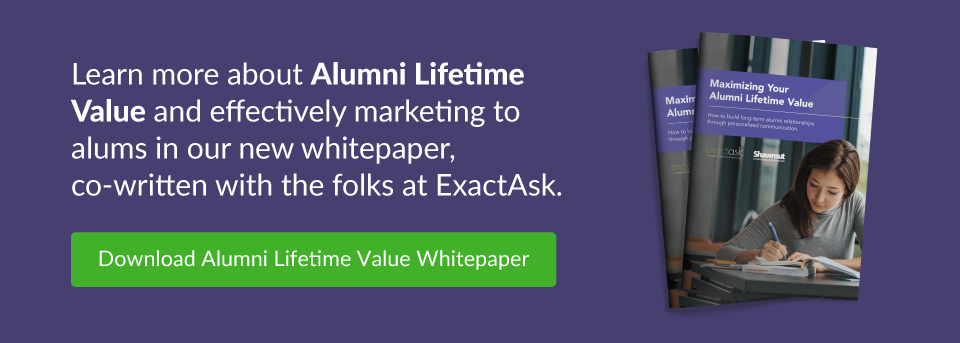Higher education institutions rely on alumni for donations, but most encounter the same fundraising problem year after year called donor attrition. Fundraising and development teams are fighting for new donors, while existing donors and alumni continue to disappear.
To offset donor attrition many colleges and universities prioritize short-term wins and cost-cutting solutions. For example, to boost the response rate and demonstrate the “performance” of a single alumni appeal program, development teams tend to suggest a safe, low donation amount for everyone in the donor database. Eventually this campaign-centric approach which favors short-term successes over long-term relationships leads to a decline in giving over time.
The key to solving the donor attrition problem lies in shifting focus away from segmented, campaign-centric analysis and towards an Alumni Lifetime Value (ALV) model. Alumni Lifetime Value is, in its simplest expression, a calculated value that represents your best prediction of the total amount any given individual will contribute to your institution over the course of their lifetime.
When you communicate with your audience keeping a lifetime value perspective in mind, two things will change almost immediately. The first is a complete re-evaluation of your Return on Investment metrics. The cost of acquisition for each contact will be redefined, now balanced against an individual’s total lifetime donations, instead of the expense of a single direct mail piece or marketing campaign. Another measurable shift is the focus away from short-sighted, acquisition-driven campaigns (that essentially allow for ‘quick wins’, but suffer the same degradation fate) and towards preventing alumni value dissolution.
Here are seven strategies for building relationships and maximizing Alumni Lifetime Value:
- Communicate Without Asking For Money
Most alumni expect that each time they hear from their alma mater, they’re receiving a donation request. This negative mental association can help explain why so many outreach efforts don’t make it past a recipient's mailbox or inbox. To start building a relationship with alumni, try disrupting this perspective by varying your communications. Create an alumni magazine, newsletter or direct mail campaign that provides school updates, success stories, and information on how their donation makes an impact. Use the start of each school year to plan and execute these outreach methods.
- Give Them Credit
Alumni are just like everyone else, motivated by both intrinsic and extrinsic reward, so provide opportunities to give them public acknowledgment. A Wall Street Journal report found that this can increase the likelihood to give AND donation amounts. Yale alums who had the opportunity to have their names published in a newsletter if they donated a certain amount were 13.7% more likely to give, compared to 11% who were not given the public recognition incentive. Additionally, the average gift size increased by 14% amongst the group offered the newsletter shoutout, contributing $66 on average, versus the anonymous group’s $58.
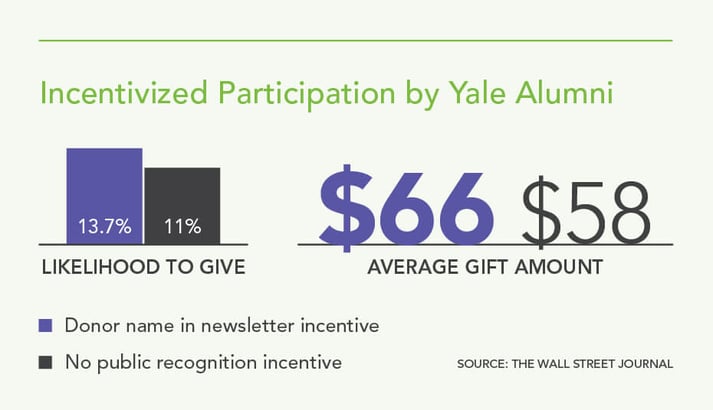
- Always Say Thank You
It goes without saying that appreciation and stewardship are a big part of retaining alumni donors, but you need to go beyond a basic thank you letter or contribution receipt. One way to encourage repeat donors is to establish a program that recognizes alumni who give for two consecutive years or more. List them in a special section of the website, send a handwritten thank you card, or give them a special name badge at alumni events. Ask your most active alums how they’d like to be recognized for an opportunity to gain deeper insight that you can plan to execute in the following year.
- Get Alumni Involved
When it comes to building relationships with alumni, make sure it’s not one-sided. Create opportunities for alumni to get involved without opening up their checkbook. Provide recent grads with career resources, job coaching, networking/mentoring/volunteering programs, reunions, or opportunities to lead school committees or participate in campus tours and events.
- Use Compelling Photos of People
While images and renderings of a new building on campus might look beautiful, they don’t evoke an emotional reaction. Instead, use photos of real students and alumni in real settings (your campus, the community, etc.) and build a library of photos that target your fundraising areas. For example, if you’re raising money for the school of science, show images of students in the lab and other settings related to that specific cause.
- Connect Donations to a Specific Need
Once you’ve identified programs that match alumni interests, make sure you connect your ask to that specific need. It’s even better if you can send the appeal after you’ve shared some recent updates about that program through a personalized newsletter or email.
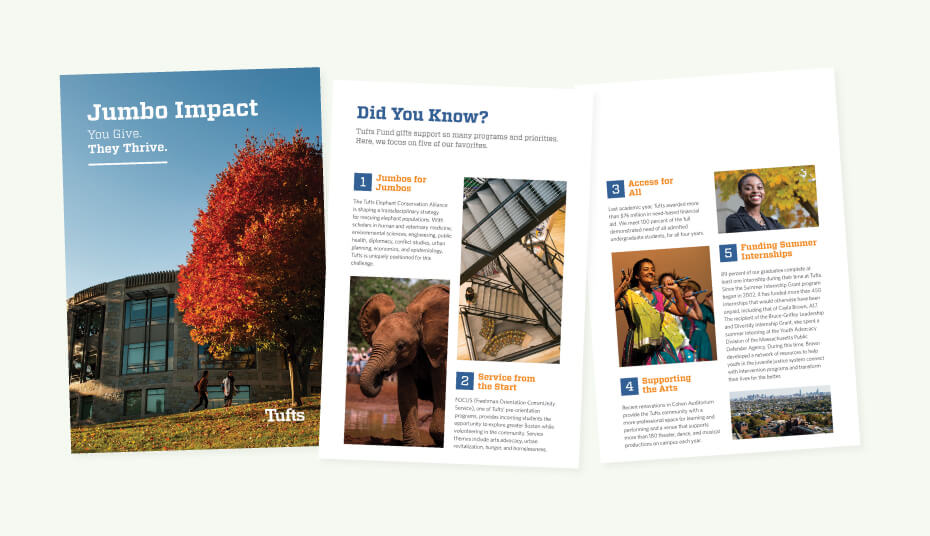
For example, if you’ve identified a particular alumni segment that is interested in athletics, send them a success story, team update or photos of recent wins (this can be through email, print or even social media). Then follow up with an appeal tied specifically to athletic programs like sports scholarships or field renovations. Alumni will be more likely to give when they feel connected to the cause and can see the potential impact.
- Speak in the first person
Using “you” and “I” allows for ongoing relationship cultivation, and camaraderie building. This also shows alumni that there are real people behind the ask. For more recent alumni, you can also send appeals from department chairs or professors that they had a positive relationship with.
Shifting the focus of your development and fundraising teams toward the ALV model seems like a long-term goal, but these actionable steps can help you start fighting the donor attrition problem today. Development teams that actively work to re-frame their alumni communication methods in 2018 are far more likely to see greater engagement, cultivate longer relationships with alums, and yield a significant bump in their donations.



